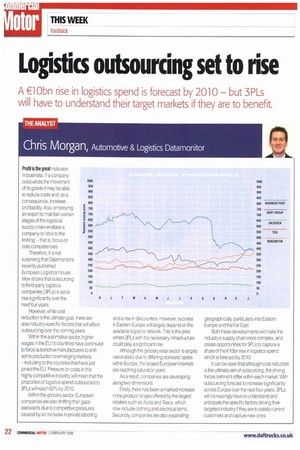Logistics outsourcing set to rise
Page 22

If you've noticed an error in this article please click here to report it so we can fix it.
A El Obn rise in logistics spend is forecast by 2010 — but 3PLs will have to understand their target markets if they are to benefit.
Profit is the great motivator in business. If a company outsources the movement of its goods it may be able to reduce costs and, as a consequence, increase profitability. Also, employing an expert to maintain certain stages of the logistical supply chain enables a company to 'stick to the knitting — that is, focus on core competencies.
Therefore, it is not surprising that Datamonitor's recently published European Logistics House View shows that outsourcing to third-party logistics companies (3PLs) is set to rise significantly over the next four years.
However, while cost reduction is the ultimate goal, there are also industry-specific factors that will affect outsourcing over the coming years.
Within the automotive sector, higher wages in the EU15 countries have continued to force automotive manufacturers to shift some production to emerging markets — including to the countries that have just joined the EU. Pressure on costs in this highly competitive industry will mean that the proportion of logistics spend outsourced to 3PLs will reach 60% by 2010.
Within the grocery sector. European companies are also shifting their gaze eastwards due to competitive pressures caused by an increase in private labelling and a rise in discounters. However, success in Eastern Europe will largely depend on the available logistics network. This is the area where 3PLs with the necessary infrastructure could play a significant role.
Although the grocery retail sector is largely nationalistic due to differing domestic tastes within Europe, the largest European markets are reaching saturation point.
As a result, companies are developing along two dimensions.
Firstly, there has been a marked increase in the product ranges offered by the largest retailers such as Asda and Tesco, which now include clothing and electrical items. Secondly, companies are also expanding geographically, particularly into Eastern Europe and the Far East.
Both these developments will make the industry's supply chain more complex, and create opportunities for 3PLs to capture a share of the €10bn rise in logistics spend which is forecast by 2010.
It can be seen that although cost reduction is the ultimate aim of outsourcing, the driving forces behind it differ within each market. With outsourcing forecast to increase significantly across Europe over the next four years. 3PLs will increasingly have to understand and anticipate the specific factors driving their targeted industry if they are to satisfy current customers and capture new ones.




























































































































































































